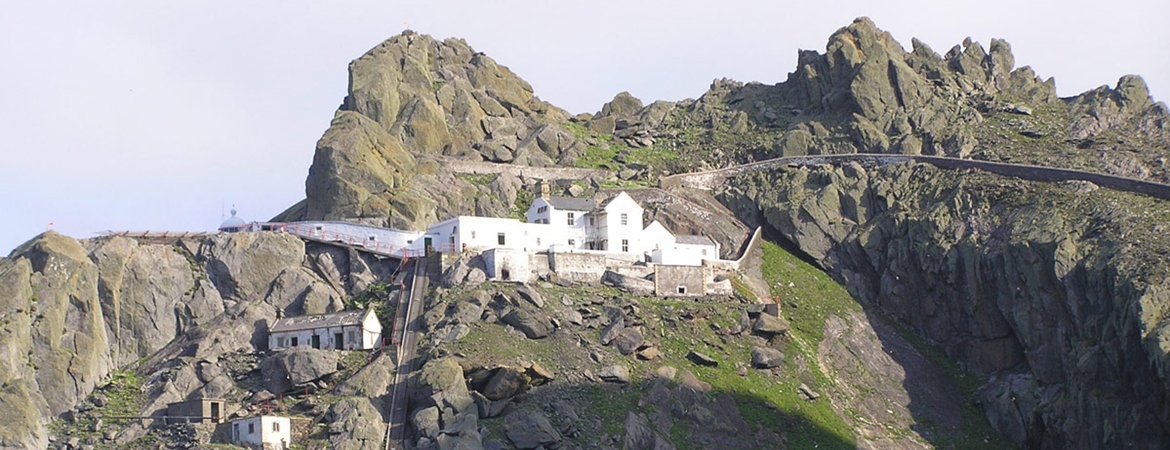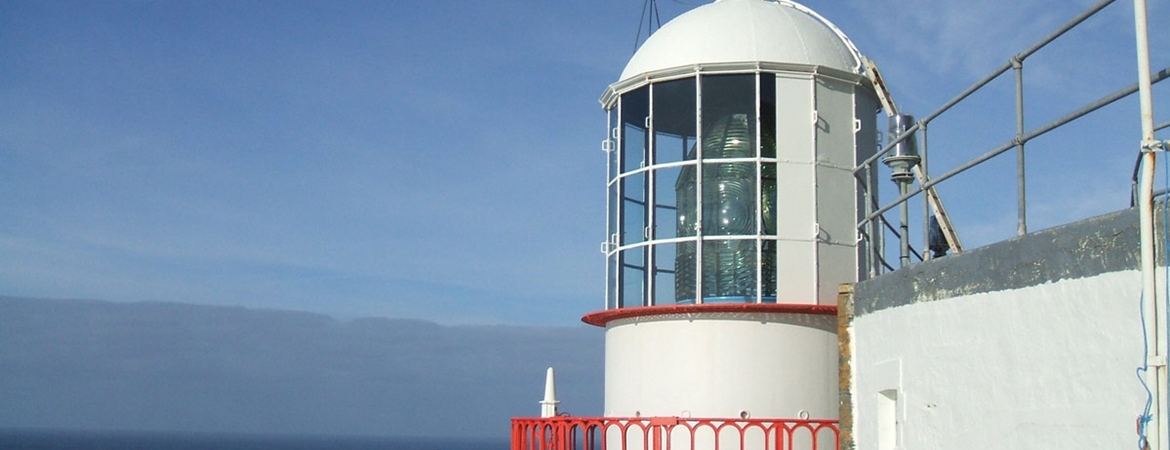In 1863 the Inspecting Committee accompanied by Captain Sullivan of the Board of Trade and a committee from Trinity House inspected the Foze Rocks. Trinity House still maintained that the Foze Rocks was the best position claiming that they had built lighthouses on equally as exposed rocks. The Ballast Board held on to their preference for Inishtearaght and in September 1863 after much correspondence the Board of Trade directed the Ballast Board to erect a lighthouse on Inishtearaght. Another year went by before legal possession was obtained. The island belonged to the Earl of Cork; a Miss Hussey also had an interest.
Inishtearaght (the Western Island) is one of the Blasket Islands, the most westerly land in Europe apart from the nearby Foze Rocks. The island is inhospitable - two steep pinnacles rising to 349 feet and 656 feet, joined by a saddle and a more rounded peak of 597 feet.
In the meantime the Ballast Board's consultant engineer, Mr C.P. Cotton, reported that a quantity of rock would have to be removed to form a platform for the lighthouse and dwellings, and steps would have to be cut to make landings both north and south. He stated that this work would probably be carried out during 1864-65. In January 1864 an ex Trinity House steam tug Bishop was repaired and used to convey materials, men, and provisions from Dingle to the rock.
Mr Cotton visited the rock in April 1864 and surveyed a possible site for the lighthouse, stating that the western peak was 349 feet above high water and a site at 240 feet could be obtained without difficulty. He suggested having only a lantern with blocking rather than a tall tower, and removing rock to the north and south of the peak to open up Inishvickillane and Inishtooskert, the rock being hard sound conglomerate. The dwellings would be on the south side of the peak at 263 feet, 90 yards from the light, with a covered approach if necessary. Landings and steps should be constructed first before the platforms for the lighthouse and dwellings.
During August 1864 the Board received a letter from General Sir John Burgoyne, Royal Engineers, offering assistance from sappers to blast the rock. The Inspector, Captain Roberts, declined the offer due to lack of accommodation on the rock. Sir John was thanked by the Board.
Mr Cotton reported again in April 1865 that men who had spent the previous summer and winter on the rock had formed landing places and approaches and blasted away sides of rock. The quarry men had cut into the western side at a level of 264 feet for a distance of 50 feet and Inishvickillane and Inishtooskert would soon be opened up. The rock which was in good sound order could be dressed well for good desirable building stone. This can be seen on the unpainted portion of the tower, the rest being painted white. When it was impossible to work at the west side of the peak the men moved over to the south preparing the site for the dwelling.
During the summer of 1865 the boilers of the Bishop had to be repaired so a hooker of John Flaherty (presumably of Dingle) was used.
During October the same year Mr J.S. Sloan, who at that time was Superintendent of Works and later became Engineer after Mr Cotton, was instructed to visit Inishtearaght to take the necessary measurements to enable him to prepare plans for the lighthouse and dwellings and, for the sake of economy, suspend works during the winter and bring the Bishop up to Dublin for boiler repairs. By March the following year plans were submitted and the Engineer reported that it would cost another £4,000 to clear the rock for the lighthouse. The Board ordered that the rocks were to be cut down. This proved to be tougher than expected and after a site inspection during the summer Inspector Roberts suggested that as the rock was now down to 263 feet the light could be set at 275 feet, the same height as Loophead; siting the light 12 ft lower would entail blasting a further 5,000 cubic yards of rock, or for 18 ft lower, 10,000 cubic yards, with nine and eighteen months delay respectively. The Board approved Inspector Robert's suggestion to leave the site as it was and have the light at 275 feet above high water. The Board of Trade was informed and sanctioned £13,108.19.0 expenditure on the new station.
The men working on the rock threatened to strike in 1866 unless their wages were increased. Masons and stonecutters wanted 4d per day to their 5/- per day and plasterers 6d to their 3/6. Their request was granted without hesitation.
In 1867 the Commissioners of Irish Lights became a separate entity responsible for lighthouses and other aids to navigation around the coast of Ireland, but having the same constitution as the Ballast Board.
By 1868 progress was fairly well advanced and tenders for iron work were secured by Edmundson of Dublin. The Board also approved their tender for the cast iron ladder, blocking, balcony, and railings which was £19 higher than that of Chance Bros of Birmingham but the Board of Trade, which was familiar with Chance's work, insisted on their quotation being selected. Chance Bros also supplied the first order holophotal light showing a flash every one and a half minutes. Before being installed into Inishtearaght it was exhibited at the Paris Exhibition of 1869.
Towards the end of 1869 the Inspector presented a draft Notice to Mariners stating that the light would be exhibited on 4th May 1870 and that at the same time Skelligs Upper Lighthouse would be discontinued. In fact the light was lit on 1st May, three days earlier. The two Keepers, with their families, lived on the rock.
In 1880 the Commissioners' Inspecting Committee on Tour recommended an improvement in the light. The optic was replaced in 1883 by a first order double-flashing light manufactured by Edmundsons of Dublin.
It was reported that on the 5th January 1890 during a severe thunderstorm the middle peak was struck by lightning and scattered a large quantity of rock.
A request in 1896 from the Keepers that the station be made relieving was sympathetically received by the Commissioners and, although the Keepers offered to pay their own lodgings until dwellings were constructed, sanction was obtained to lodge the Keepers of both Skelligs and Inishtearaght on Valentia Island from December 1896. A fine terrace of eight two storey houses was built behind Knightstown and occupied towards the end of 1900 or soon after.
An aerial hoist on the rock over the south landing was erected during 1906-07. Incandescent apparatus using vaporised paraffin burnt in a mantle replaced the multi-wick oil burner in March 1909.
Early in December 1909 the Limerick Harbour Board requested fog signals on a number of west coast stations, among them Inishtearaght. After a certain amount of correspondence the Board of Trade sanctioned a siren type fog signal for Inishtearaght. This meant an engine room had to be constructed for the compressor sets and the Engineer, Mr C. W. Scott, selected one of the two Keepers' houses. Unfortunately the one he required was the better of the two and was occupied by the Keepers on duty on the rock. They complained, and before the left hand house could be converted, the other house had to be renovated.
In 1913 the Board of Trade sanctioned the installation of Reavell compressors and Petter oil engines. New derricks and an inclined railway were constructed and the south landing was rebuilt. Wheels were fitted to the fog signal air receivers so they could be hauled up the rock on the railway. A decision to fit a diaphone instead of a siren for the fog signal was taken in 1914. Work on the fog signal plant was suspended in 1915 and it was not until 1st January 1925 that the fog signal was completed and established.
On the 12th September 1913 one of the Assistant Keepers fell to his death over the cliff whilst catching goats for milking. Compensation was eventually paid but a remark was made by the Commissioners that the goats were the Board's property and it was up to the Keepers to look after them.
A rock fall at the east landing caused it to be officially abandoned in April 1914. It had not been used for the previous five years.
Proposals to electrify the station were made in 1954. Because of delays in finalising the specification of the new equipment, work did not commence until 1960. The electric light was put into operation at sunset on 23 October 1961. The new light had a character of two flashes every 20 seconds (Gp Fl W (2) ev. 20 secs) and the candle power was increased to 1,600,000. The light was an electric MBI/BD 1 kW lamp in the existing 920mm catadioptric annular lens. From 1978 the light was exhibited in poor visibility when the fog signal was sounding.
In 1980 the fog signal was converted from diaphone to an electric horn with 3 blasts every 45 seconds. The fog-signal was discontinued on 1st May 1987.
On 6th April 1988 the lighthouse was converted to automatic operation and the Keepers were withdrawn from the station. The station was placed in the care of an Attendant and the aids to navigation were monitored via a telemetry link from Dun Laoghaire. Subsequently the inclined railway was decommissioned and the derricks removed.
A Racon (radar transponder beacon) was established at Inishtearaght Lighthouse on 10 June 1992.
The station was the subject of a major re-engineering and solarisation project during 2003. There had always been concern about the power required to rotate the large first-order lens at Inishtearaght which is supported on ball bearings. The General Lighthouse Authorities' Research and Development Department identified efficient DC stepping motors capable of rotating the optic at the required rotation speed which consume about 20 Watts continuous power. A 35 Watt etched metal halide discharge lamp replaced the 1kWatt metal arc lamp to provide a light of 19 nautical miles. Forty eight Solarnova 50 Watt solar panels, arranged to charge two parallel connected 24 volt 2,750 Ampere hours lead acid batteries were mounted on stainless steel frames in front of the operations room close to the helipad.
The operations area was reduced in size, and rooms were built to house the equipment and the 132 battery cells. The monitoring system was replaced with a Datac 932 unit that operates directly over the cellular communications network to the central monitoring station in Dun Laoghaire. The dual band X/S racon (radar transponder beacon) was retained.
A TS3 diesel generating set, which can be switched on remotely from Dun Laoghaire to charge the main batteries if required, was installed; this generator also provides domestic power for visiting personnel. Two of the three existing generators were removed, the third having been left as a back-up. The new light came into operation on 26th September 2003 with a range of 19 nautical miles, the light to be exhibited in hours of darkness only.





